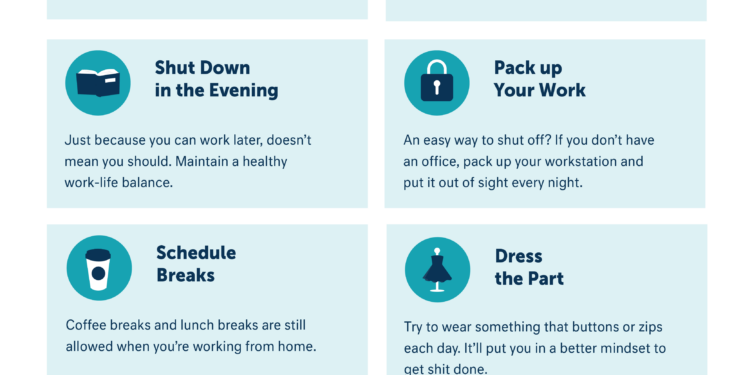In today’s fast-paced digital world, adopting best practices for remote work is essential for effective performance and well-being. As more people embrace telecommuting, knowing the right remote work tips can boost productivity and create a harmonious work-life balance. Establishing efficient work from home best practices, such as creating a dedicated home office setup, ensures that you stay focused and organized throughout your day. Furthermore, managing a remote team requires a unique approach, as clear communication and collaboration are crucial for success. By implementing these strategies, remote workers can enhance their productivity and achieve their professional goals without compromising personal time.
Transitioning to a decentralized workplace presents its own set of challenges and opportunities. Embracing the concept of virtual job performance entails setting clear standards and routines to optimize your daily workflow. Learning to navigate the landscape of flexible employment demands an understanding of remote team coordination and innovative communication tools. As workers adapt to this new norm, fostering a productive environment at home becomes increasingly vital. Whether you’re a seasoned telecommuter or new to the remote work lifestyle, finding effective methods to maintain engagement and efficiency is key.
Best Practices for Remote Work
Implementing effective best practices for remote work is essential for fostering a productive environment. Firstly, establishing a structured daily routine can significantly enhance focus and time management. Workers should begin their day with a clear set of goals and prioritize tasks to ensure they stay on track. Additionally, using digital tools for planning, such as calendars and task management software, can streamline workflows and improve overall productivity.
Communication is another cornerstone of effective remote work. Utilize video conferencing tools to facilitate face-to-face interactions, even when working from home. Regular check-ins with team members nurture a sense of community and collaboration, helping remote workers feel connected despite physical distances. Investing time in building relationships and setting clear communication guidelines can lead to improved remote team management.
Creating an Effective Home Office Setup
A well-designed home office setup is crucial for remote workers seeking both comfort and productivity. To create an optimal workspace, consider ergonomics; for instance, investing in a good chair and desk can reduce strain and improve posture. Additionally, personalizing the workspace with motivational decorations or plants can enhance mood and creativity. Proper lighting should not be overlooked as it affects focus and energy levels throughout the workday.
In addition to physical arrangement, the technological aspect of a home office is vital. Ensure a reliable internet connection to support smooth video calls and quick access to resources. Setting up dual monitors can aid in multitasking and efficiency, while the right software and tools can simplify daily tasks. Regularly assess your home office setup and make adjustments as necessary to improve the remote work experience.
You might also consider establishing boundaries within your home office. This includes designating specific work hours and communicating these boundaries with family members or roommates to minimize distractions. A clear separation between work and personal life can contribute significantly to a remote worker’s productivity and focus.
Essential Remote Work Tips for Increased Productivity
To maximize productivity while working remotely, it is essential to develop routines that promote efficiency. One effective tip is to time-block tasks throughout the day. By allocating specific blocks of time to tasks, remote workers can create a sense of urgency that helps in achieving targets faster. Furthermore, incorporating regular breaks into the schedule ensures workers do not experience burnout and maintain their energy levels throughout the day.
Additionally, leveraging technology to enhance productivity is crucial. Tools such as project management software allow remote teams to coordinate effectively, providing transparency in project status and deadlines. Incorporating productivity tracking applications can help individuals assess how they spend their time, leading to better adjustments and improved focus on important tasks. These remote work tips can transform how workers operate independently at home.
Enhancing Communication in Remote Team Management
Effective communication is at the heart of successful remote team management. Without face-to-face interactions, it is vital to establish clear and consistent lines of communication among team members. Regular updates via email, team chats, and virtual meetings help keep everyone aligned, ensuring that tasks are understood and progress is tracked efficiently. This practice fosters a collaborative atmosphere, even when teams are physically separated.
Furthermore, it is important to encourage open feedback and dialogue within remote teams. Creating an environment where team members feel comfortable sharing their ideas or concerns can enhance team dynamics and encourage innovation. Consider structuring regular meetings to allow team members to discuss challenges and celebrate successes. This transparency can strengthen relationships and enhance overall team cohesion.
Work From Home Best Practices for Maintaining Work-Life Balance
Maintaining a healthy work-life balance is crucial for remote workers to prevent stress and burnout. One of the best practices for achieving this balance is to establish a clear distinction between work hours and personal time. Setting specific start and end times each day helps create a routine and allows individuals to mentally shift from work mode to personal time, helping preserve energy and motivation.
Another best practice is to incorporate routine physical activity into the daily schedule. Taking breaks to exercise or enjoy fresh air can significantly enhance one’s mood and productivity, helping to recharge after long work sessions. By consciously taking time for both work and personal enrichment, remote workers can cultivate a more harmonious and fulfilling work-from-home experience.
Strategies for Boosting Productivity for Remote Workers
Boosting productivity for remote workers often requires strategic approaches tailored to individual preferences and work styles. One effective method is the Pomodoro Technique, which involves working in shorter bursts of time — typically 25 minutes followed by a 5-minute break. This technique helps maintain concentration and reduces fatigue, allowing workers to achieve higher levels of productivity without feeling overwhelmed.
Another strategy to enhance productivity is to customize the work environment according to personal preferences. For instance, some may work best in complete silence, while others thrive with background music or ambient noise. Experimenting with various workspace arrangements and auditory settings can lead to discoveries that maximize efficiency and comfort, resulting in a better remote working experience.
Utilizing Technology for Effective Remote Collaboration
In today’s digital workspace, the use of technology is imperative for effective remote collaboration. Platforms such as Slack or Microsoft Teams provide seamless communication solutions for remote teams, ensuring that collaboration and information sharing occur instantly. With proper use of these tools, team members can work together on projects in real time, enhancing overall productivity and cohesion.
Moreover, virtual collaboration tools like Google Workspace or Trello allow for real-time collaboration on documents and projects, making it easier for remote workers to stay on the same page. Emphasizing the importance of documenting processes and decisions can also foster clarity and accountability within remote teams. By embracing such technology, organizations can cultivate a thriving remote work environment.
Balancing Distractions in a Home Office Environment
While working from home offers flexibility, it can also present unique distractions that hinder productivity. To combat this challenge, it’s essential to identify potential distractions in your environment and implement strategies to minimize them. This might include setting specific times for personal chores or using noise-cancelling headphones to create a more focused atmosphere.
Establishing a dedicated workspace away from common areas can also help mitigate distractions. Informing household members of your work hours creates a supportive home environment where they respect your focus time. By actively managing distractions, remote workers can maintain their productivity and effectively complete tasks.
Setting Goals and Objectives for Remote Work Success
Setting clear goals and objectives is vital for remote work success. Establishing SMART (Specific, Measurable, Achievable, Relevant, Time-bound) goals can provide direction and clarity for remote workers. It also helps in keeping track of progress and adjusting workflows as needed. When team members share their individual objectives, it creates accountability and transparency, fostering a collective sense of purpose within the remote team.
Equally important is the periodic review of these goals. Creating a routine to revisit objectives helps ensure that teams stay aligned and can pivot when necessary. By communicating openly about goal status in team meetings, remote workers can actively support each other’s progress, ultimately leading to improved performance and collaboration.
Frequently Asked Questions
What are the best practices for remote work to maintain productivity?
To maintain productivity for remote workers, establish a dedicated workspace, create a routine, leverage technology for communication, and set specific work hours. These remote work tips help in minimizing distractions and enhancing focus.
How can I set up an effective home office according to work from home best practices?
An effective home office setup should include a comfortable chair, adequate desk space, proper lighting, and minimal clutter. Ensuring a quiet environment and having essential tools within reach are also key components of home office best practices.
What are some tips for managing a remote team effectively?
Remote team management requires clear communication, regular check-ins, and establishing trust among team members. Use project management tools and encourage feedback to foster collaboration and streamline workflows.
What strategies can improve productivity for remote workers?
Improving productivity for remote workers involves setting clear goals, minimizing distractions, using time management techniques, and taking regular breaks. Incorporating these strategies is essential for successful remote work.
How can remote work tips enhance team collaboration?
Remote work tips, such as utilizing collaborative tools, scheduling regular video meetings, and fostering an open communication culture, significantly enhance team collaboration and ensure everyone stays aligned.
What should I include in my home office setup for remote work?
Your home office setup should include ergonomic furniture, high-speed internet, reliable hardware, and any necessary software tools. Following work from home best practices ensures a comfortable and efficient working environment.
How can I balance work and personal life while working remotely?
Balancing work and personal life in a remote work setting can be achieved by setting boundaries, having a defined workspace, and adhering to a structured schedule. These practices help in maintaining a healthy work-life equation.
What role does communication play in remote team management?
Effective communication is crucial in remote team management. Regular updates, using various communication tools, and encouraging open dialogues help in building strong relationships and ensuring everyone is on the same page.
What are common remote work challenges and best practices to overcome them?
Common remote work challenges include isolation, distractions, and time management issues. Best practices to overcome these include fostering team engagement, creating a distraction-free workspace, and scheduling time effectively.
How important is routine in maintaining productivity for remote workers?
Establishing a routine is vital for maintaining productivity for remote workers, as it helps create structure and reduces procrastination. Following a consistent daily schedule fosters focus and work-life balance.
| Key Point | Description |
|---|---|
| Establish a Routine | Set a consistent start and finish time for your workday to create structure. |
| Designated Workspace | Create a specific area in your home where you work to minimize distractions. |
| Effective Communication | Use tools like video conferencing, chats, and emails to stay connected with your team. |
| Regular Breaks | Take short breaks throughout the day to maintain productivity and reduce fatigue. |
| Work-Life Balance | Set boundaries between work and personal life to prevent burnout. |
Summary
Best Practices for Remote Work play a crucial role in enhancing productivity and maintaining a healthy work-life balance. Establishing a routine, having a designated workspace, and ensuring effective communication are essential strategies. Incorporating regular breaks throughout the day not only boosts productivity but also helps in managing stress. Lastly, recognizing the importance of work-life balance can prevent burnout and increase job satisfaction. Implementing these best practices will lead to a successful remote working experience.
Introducing Autowp, the ultimate AI content generator and AI content creator plugin for WordPress! Whether you’re looking to enhance your blog, create stunning product descriptions, or generate engaging social media posts, Autowp utilizes cutting-edge AI technology to produce high-quality content effortlessly. Boost your website’s performance and watch your traffic soar with custom-tailored articles that speak to your audience’s needs. To remove this promotional paragraph, upgrade to Autowp Premium membership.












